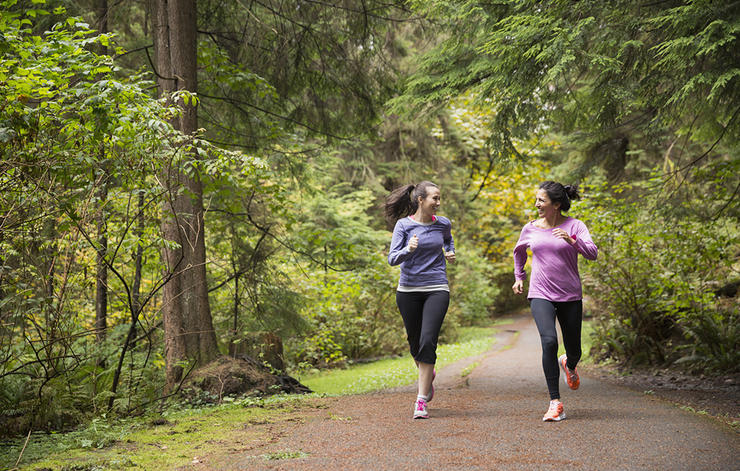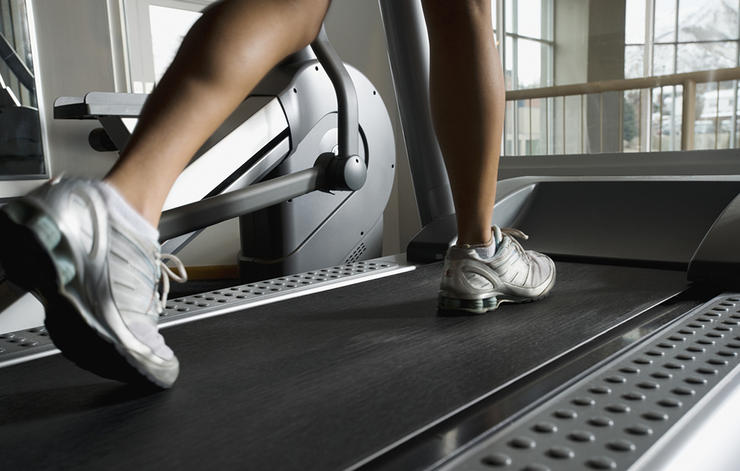Maybe you expected getting back into shape to suck—and it’s proving to be even worse than you thought. That feeling is a red flag to running experts. “That’s a sign you may be trying to ramp up too quickly. It’s always better to start more conservatively,” Bakoulis says. Not only will building up slowly help you avoid injury, which is a greater threat after 40, but it will also keep you motivated. “You don’t want to dread running or have it feel onerous.”
Not sure if you’re doing too much, too soon? Assess your efforts with the talk test: You should be able to talk comfortably without gasping for breath while you run. If you can only sputter out a word at a time, you’re working too hard, Cohen says. Turn down the speed a few notches until you are moving more comfortably.
As we get older, it takes our bodies longer to recover; it’s just a fact of life. “A 20-year-old might never think twice about sore muscles or a minor strain, but it can end up being something that aggravates an older runner for a week,” Casola says.
With that in mind, it’s important to avoid running on consecutive days. When you’re first getting started, three runs a week should be plenty. If you want to log more than three weekly workouts, add a day of strength training to your routine, Cohen says, or hop on a bicycle or the elliptical or go for a swim on another day, Casola suggests. “This type of cross-training helps you work on your cardiovascular conditioning without pounding the pavement.” (Make sure to add these 12 essential exercises every runner should do to your weekly strength routine.)
RW IN YOUR INBOX: Have the latest news, advice, and inspiration sent to you every day with our Runner’s World Newsletters.
Warm up and post-workout recovery are also important, as they help ward off overuse injuries, and problems with knees, hamstring, and calf muscles—all things older runners are more susceptible to, according to The University of North Carolina at Chapel Hill School of Medicine findings. Stretch at the end of your runs, rather than the beginnings, since cold muscles are more prone to injury. And instead, warm up with a few minutes of walking or slow jogging.
On your days off consider foam rolling or doing yoga or Pilates to soothe sore muscles and maintain a healthy range of motion. (Never used a foam roller before? Learn about the 5 different types of foam rollers—and when to use each one.)

Running is about more than fitness.
Running can be a major stress reliever, Casola says, especially if you’re getting to spend time with friends while you’re at it. She ran her first marathon two weeks before her 40th birthday and got instantly hooked on longer distances. She started doing long training runs with other runners, making more and more running friends along the way, and eventually became a coach. For her upcoming 60th birthday, Casola, her husband, and eight running friends will be celebrating at a half-marathon. “It became a very social thing for me. Some people I run with have become lifelong friends.”
For others, running is more solitary–but equally invigorating. “I affectionately call some of the women I’ve coached ‘adult-onset runners,’ meaning they weren’t athletic in their youth,” says Cohen. “For them, it’s part of a metamorphosis. When they run, they feel like an athlete. It’s about taking control of their bodies and wellbeing.” (Here’s how running brought this couple closer together, and helped them lose 180 pounds.)

It’s tough, especially with all those finish line and workout photos on Facebook, but don’t measure your running accomplishments against those of your friends, especially if they’re more seasoned runners, Casola warns. (Take note from these plus-size exercisers who have received bad advice.) Let them run their 8-minute miles while you run your 15. Be at peace while they run for an hour straight, and you take walk breaks. There are runners of all different speeds, levels, backgrounds, ages, and body types, and new runners should regularly remind themselves of that. “You are doing this for fun, for your health, not to become an Olympic athlete,” Casola says.

It’s natural for some of your initial excitement over starting a new fitness routine to wane. In those moments, “keep the end goal in mind,” Cohen says, whether it’s running in a race you signed up for, getting into shape so you can keep up with your kids, or simply feeling happier and healthier. Remember why this new habit is good for you. “Women in their 40s can be stretched in all directions,” Bakoulis says. “But running is an efficient, satisfying way to get a workout in a few times a week, spend time with friends, and have ‘me’ time.”









